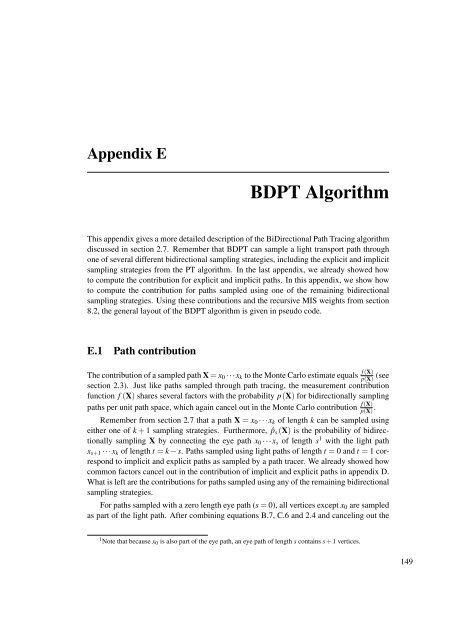Master Thesis - Computer Graphics and Visualization - TU Delft
Master Thesis - Computer Graphics and Visualization - TU Delft
Master Thesis - Computer Graphics and Visualization - TU Delft
You also want an ePaper? Increase the reach of your titles
YUMPU automatically turns print PDFs into web optimized ePapers that Google loves.
Appendix E<br />
BDPT Algorithm<br />
This appendix gives a more detailed description of the BiDirectional Path Tracing algorithm<br />
discussed in section 2.7. Remember that BDPT can sample a light transport path through<br />
one of several different bidirectional sampling strategies, including the explicit <strong>and</strong> implicit<br />
sampling strategies from the PT algorithm. In the last appendix, we already showed how<br />
to compute the contribution for explicit <strong>and</strong> implicit paths. In this appendix, we show how<br />
to compute the contribution for paths sampled using one of the remaining bidirectional<br />
sampling strategies. Using these contributions <strong>and</strong> the recursive MIS weights from section<br />
8.2, the general layout of the BDPT algorithm is given in pseudo code.<br />
E.1 Path contribution<br />
f (X)<br />
p(X) (see<br />
The contribution of a sampled path X = x0 ···xk to the Monte Carlo estimate equals<br />
section 2.3). Just like paths sampled through path tracing, the measurement contribution<br />
function f (X) shares several factors with the probability p(X) for bidirectionally sampling<br />
f (X)<br />
paths per unit path space, which again cancel out in the Monte Carlo contribution p(X) .<br />
Remember from section 2.7 that a path X = x0 ···xk of length k can be sampled using<br />
either one of k + 1 sampling strategies. Furthermore, ˆps (X) is the probability of bidirectionally<br />
sampling X by connecting the eye path x0 ···xs of length s1 with the light path<br />
xs+1 ···xk of length t = k − s. Paths sampled using light paths of length t = 0 <strong>and</strong> t = 1 correspond<br />
to implicit <strong>and</strong> explicit paths as sampled by a path tracer. We already showed how<br />
common factors cancel out in the contribution of implicit <strong>and</strong> explicit paths in appendix D.<br />
What is left are the contributions for paths sampled using any of the remaining bidirectional<br />
sampling strategies.<br />
For paths sampled with a zero length eye path (s = 0), all vertices except x0 are sampled<br />
as part of the light path. After combining equations B.7, C.6 <strong>and</strong> 2.4 <strong>and</strong> canceling out the<br />
1 Note that because x0 is also part of the eye path, an eye path of length s contains s + 1 vertices.<br />
149
















